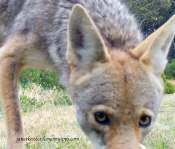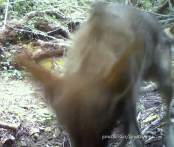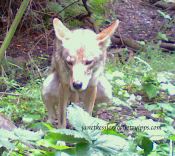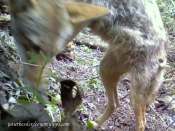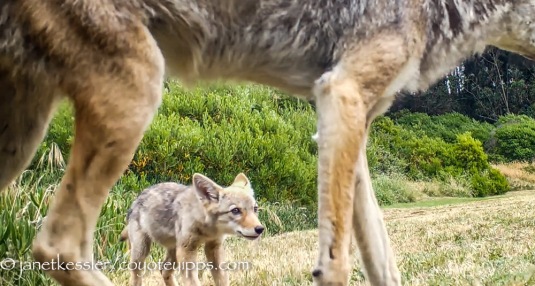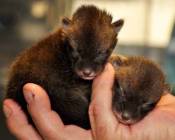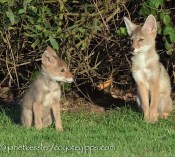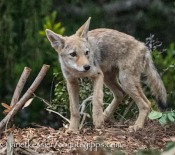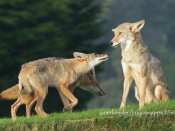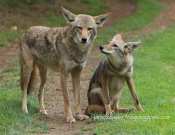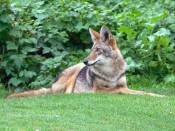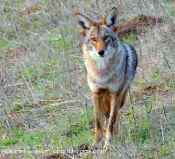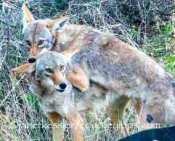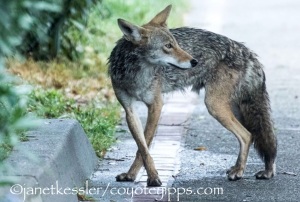Within the past couple of weeks, coyote pups were born here in San Francisco. Whatever defensive patterns coyotes had before the pups were born have now been compounded. Especially if you have a dog, you need to know and understand them for what they are. I wrote this three years ago: what I say and how I say it can’t be improved upon, so here it is again for you. Janet
“Running Away From Home”
06 Jun 2022 4 Comments
in coyote behavior, coyote pups left alone, denning, exploring, families, feeding pups, pupping

Well, “running away from home” isn’t exactly what happened (which is why I have the title in quotes), but watching a tiny kitten-size pup the other morning trekking decidedly away from his home inspired the idea. For a fun twist, I put together the above collage, and have written this posting sprinkled with that thought.
The morning began with a coyote dad bringing in a mouthful of animal-prey to his denning area. It was too far off and I wasn’t quick enough to see what they prey was, but it was the size of a large duck. He disappeared into the brush, and I hoped I would see him again. Within a very short time, I heard a coyote calling to another — I wasn’t given enough lead time to record it, it was not a sound I hear often: a short, warbled sound.
I looked up to where the sound came from and saw him standing and apparently waiting close to where I had seen him disappear earlier. He had been calling to his mate, because within a minute, she joined him. As they headed off, one and then two of their pups attempted tagging along. They either were told *no* or knew they wouldn’t be able to keep up because they immediately turned back. Youngsters desperately want to be with their parents, but no means no, and they were left in the safety of their den area. That was all I saw of the parents that morning.
One pup of this litter is a runt. I’ve observed runts before. They often don’t play with litter mates because their size makes it not fun for them: who likes to be beat up all the time? So they frequently play by themselves. And they go off by themselves. I’ve also seen runts given special attention by their parents: the extra nurturing probably helps their survival. Mom was there today most likely to nurse them, and I saw Dad bring in solid food as I stated above. I wondered if the runt might have been unable to get his share of milk or of what was brought in by Dad? I thought of these things immediately after what I saw next.






Leaving the den took several tries, each ending with his return to the den. On the fourth try, he made it across 100 yards of ‘treacherous terrain’, including flower beds, trees, lawn, and paved paths.
Within the next ten minutes, I saw the runt heading off and away from his denning area. My eyes popped out of my head when I saw him because it was broad daylight and he was so tiny — so much smaller than other pups at this stage of their development — he was alone and completely vulnerable out in the open in a high foot-traffic and dog area, and in the daylight. I seldom see pups, much less traveling alone over vast expanses of open areas where they are totally visible. Of course, I kept my eye on him to see what he was up to. He moved with purpose, the same way you see the adults do: they always seem to know where they are going and what they are doing. Thrice he turned back after about 100 feet, as though he were trying to make up his mind whether to proceed. But the fourth time he reached the point where he had turned around before, and he made a sudden dash forward, across a network of paved paths and a large open lawn. I was able to watch him for about 100 yards before I lost track of him in the ivy. Ivy is a wonderful coverup for them. If a dog had been there, that might have been his end, and I prepared myself to grab any unleashed exploring dogs, but none happened by at the time.
My next post will be about dens, but here I need to state that immediate denning areas are larger than the size of football fields — they don’t simply encompass the temporary dugout birthing den — they are much larger areas than that. Parents will defend this football field size area and more than 1/4 mile beyond it. This youngster was well within his football field area, but because of his direct trajectory, the idea of his running away from home popped into my mind and made me smile. I wondered about the issues faced by a runt: his likely inability to compete for a fair share of the milk or food brought in. I wondered if there might be more going on than simply being a runt: such as illness? He was wobbly in his steps and rickety in his appearance, with bug bites over his back and watery eyes. That’s all I saw of him in the morning and those were my thoughts. No parent was present to lead him back or protect him had he needed it.



Dad waits outside den area for mom to finish nursing and then tires of waiting and leaves.
In the evening his parents returned and everything looked normal. It is customary for parents to leave their pups all day long. They tend to stop by very sporadically, including at dusk for nursing or feeding before heading out again. They are not at the densite often, though Dad in particular, will hang out within several hundred feet, snoozing away the daylight hours and performing his sentry duty. This evening when she came, Mom disappeared into the brush and Dad waited for her on the periphery. He waited and waited, and finally trotted on by himself because Mom was not appearing. I saw her later playing with two of her pups. I could see that Runt was not among them. I despaired for him.

The next morning I was there to observe any changes, and to docent, asking folks to please keep their dogs leashed. I saw Dad looking around, but he didn’t seem particularly concerned. Another thought popped into my head: Being the runt, this one looks somewhat like a kitten with its exceptionally short baby snout. What if some human were to *save* him by either adopting him or taking him into the SPCA or ACC. It is illegal to keep wildlife as pets here. In addition, separating a youngster from its family drastically diminishes the youngster’s chances of survival. Few animals taken to wildlife rehab centers survive in the long-run: they simply have not been given the skills to survive: only parents can do this. Please leave all found pups alone — you can only hurt their situation.
I was back in the evening and heaved a sigh of relief when I glimpsed Runt. He’s there! For him, it was just another day, as if nothing special had happened over the last 24 hours — and it hadn’t — but for me, I wrote a whole post about him running away from home and ruminating about a runt’s welfare. But these little guys are hardy and resilient and much smarter than we think. However, it’s important to remember that pup survival rate can be as low as 20 to 30%.

PS: Although I distinguish coyotes by their faces, I have real trouble distinguishing pups. However, Runt stands apart and is very identifiable by his underdeveloped size and ragged/rickety appearance. He’ll probably emerge as King of the Forest some day!! :)
Feeding Pups
20 May 2022 2 Comments
in coyote behavior, coyote pups, feeding, feeding pups, nursing, pupping, regurgitation
Imagine having to keep up with the nutritional needs not only of yourself — that must be hard enough — but also of FIVE ravenous pups you’ve brought into the world! The nutritional needs of growing pups is tremendous!
This top video shows a mother coyote nursing four of her five 4-week-old pups. She is ever so patient through the frenzy of hungry little stomachs! I timed this feeding: it was done and over in just one minute and forty seconds: that’s how long a nursing session is.
I noted that within just three weeks of their birth, Mom was already bringing in semi-solid food in her stomach which she regurgitated for the pups: her milk just wasn’t enough for them.
In this next video, below, youngsters are poking at Mom’s mouth: that’s where they know solid food comes from. Young pups are ALWAYS hungry and they pester Mom until she delivers! Watching it for any length of time makes you wonder how she copes with it.
In the next few weeks, they will switch entirely to regurgitated food. I’ve seen regurgitated food continued to be brought in — though much less frequently as the pups continue to grow and become capable of hunting for themselves — for up to a year in some families: I wonder if this is a way of just keeping those pups around? Mom and Dad will do this as as they teach their brood how to hunt and where to find food.
Here is a video showing a different mother last year, regurgitating for her four-month-old pups in August. And here is a posting of a dad regurgitating food for his yearlings.
Pups Emerge from their Den
04 May 2022 1 Comment
in coyotes and dogs, milder dogs, pupping
Less than a week ago, on April 28th, these pups emerged for the first time from their den. The timeline is about the same in all the territories here in San Francisco. I wanted to share what the brand new pups look like, taken with a field camera. These are three weeks old and Mom is already regurgitating solid food for them, though they’ll continue nursing for another month.
Stewardship and guidelines for coexistence are easy, but you have to abide by them to keep coyotes, dogs and people happy and safe. The important thing is to keep away from them and their denning areas. They will be extremely protective especially during pupping season: the only thing they own and care about is their families right now.
Dogs are their biggest problem — dogs go after them constantly. As far away from their dens as 1/4 mile and more, they will approach dogs (as they do non-family coyotes) to message them to keep away. This is why it’s much less important for folks to know exactly where a den is than to know that it’s denning season. If you’ve been seeing coyotes in your area, you can pretty much be sure they are pupping and therefore will exhibit protective behavior which extends far beyond the den itself.
If you stay vigilant and keep your dog leashed, and then walk away from a coyote when you see one, you will be protecting both your dog and the coyote. You will probably not run into a coyote that often, so this isn’t a lot to ask. Any dog that isn’t leashed in a coyote area is actually free to chase coyotes: the owner is allowing it. Every chase (but also barking at and lunging at the coyotes while on a leash) sends the message to the coyote that the dog is an attacker — that’s how they see these things. And every such incident erodes the dog/coyote coexistence interface. If the coyotes are chased, they learn that’s what dogs do and they come to expect it and become more ready for it and willing to put up a defense. Respect is granted when it’s earned.
Small dogs and cats are a totally different issue because they can be seen as prey, no different from a rabbit or skunk. When you walk your small dog, please keep it leashed and close to you — not on a long extended leash. And, again, when you see a coyote, shorten that leash even more and walk away. You might have to pick up the small dog as you go if the coyote comes towards you. So please, be safe, keep your dog safely away — far enough away to keep them from reacting to the coyote by barking and lunging in their direction: this is the best way to respect our wildlife and to build respect from them.
Small children have been in the news recently as the result of coyotes approaching and biting them. This is not only rare, it is extremely rare. Humans feeding coyotes may be behind this, but also just the fact that it’s denning season I’m sure is an influencing factor. Again, please stay vigilant and keep small children close to you at all times.
Pupping Is On!
05 Apr 2022 6 Comments

Out of the 16 territories I’ve mapped here in San Francisco (and I fully assume there are several more that I’ve missed), I’m able to follow six and sometimes seven of the families more closely. The expectant mothers I’m keeping tabs on this year range in age from 5 to 7, 8 and 9. I can only guess the age of two of them, but they appear younger than 4 years old. Of these, four have given birth over the past week, and I haven’t yet been able to confirm the other two, but they are imminent. Pupping season is in full-swing!


An alpha female’s change from pregnant to postpartum last week.
It seems that expectant coyote mothers avoid being out in the open where they can be seen. Since February, my sightings of them have been extremely sparse. I think it’s because they feel more vulnerable — the same as after they’ve sustained an injury, and the same as when they get old, as debilitating deteriorations set in. They keep themselves protected by keeping out of sight. So I have sparse images this year of obviously pregnant coyotes, but my field camera was able to capture the above images of the same alpha female over the last week, showing her change from quite pregnant to postpartum.


Younger mothers seem able to hide their nursing status much better than older moms, especially as the weeks go by. The abdomens of all nursing moms becomes bald — the better to feed the youngsters — but a triangle of fur sometimes hangs down and conceals what’s going on unless you know what to look for.


Nine years old apparently is not too old to have pups as confirmed by one of the mothers I’m keeping my eyes on. However, it appears that giving birth is particularly taxing on older moms, and raising the youngsters I’m sure won’t be as easy as it was when they were younger. The above eight-year-old mother looked absolutely exhausted and even depressed to me following her birthing ordeal when I spotted her in the distance as a bump on the vast golf green: when she finally noticed me, she moved only her eyelids to look at me and then closed them again. She was soaking in the heat of the sun a good 1/4 mile from the general area where I know her den is. I won’t know how many pups were born to any of the families until June at the earliest, if then — most coyote parents are very protective of their pups and often don’t even like them to be seen, and they’ll move them if they think you might be interested in them. I usually get a glimpse of some of them in June as they begin exploring further afield.
Not all coyote territorial mated pairs produce litters, or possibly, they produce them but the pups don’t always survive. Last year, we saw a 4-year-old female who had been bulging at the sides and was initially lactating but no pups were ever seen by anyone, so we assume they all perished. Pup survival rate is notoriously low for coyotes. This would have been that female’s first litter, even though the previous year the conditions were right for her — she had a territory and a mate and she was over two years old — but a litter never materialized. Other territorial mated pairs I observed never showed any signs at all that they were expecting or birthing, and there were no pups ever seen, even though the pairs had been together for over a year at least.
In one family this year — the same as occurred last year to a different family — there is a mother and daughter, BOTH of whom had been very pregnant on one territory. Last year, the daughter and her pups disappeared soon after the birth, and I’m wondering if they even survived. That mother had developed a 12 inch square gaping and angry red wound on her side which may have led to her end. Possibly her surviving pups, if there were any, were adopted and incorporated into the other family — hopefully the DNA we’ve collected will reveal all that. We’ll have to wait and see what the outcome is for the double motherhood on a territory this year: it’s an unusual situation and seems to come from less than stable or solid alpha pair relationships.

Another sign of what’s going on right now is that dads have been hanging out and guarding near their den sites. For years I used to look for the *birthing rock* where one of SF’s father coyotes hung out while Mom gave birth. After I realized why he was hanging out there, I would always look for him at this time of year, and always found him there during this short birthing period, year after year, until last year. That father passed away last year, but other dads have been doing the same thing: finding a lookout post close to their mates’ birthing dens where they stand sentry, guarding the precious new litter while Mom is unable to do so, still recovering from birthing.
Pupping Is Happening Now
29 Mar 2021 1 Comment

Well, finally our coyote pups are being born, and the reason I know this is because suddenly coyotes are not around: I’m seeing them less than before. They’ve gone “underground” into hiding, which is what they do during pupping. This is a self-protective measure during a period of time when they are most vulnerable: during birthing and into the early pupping rearing time through lactation, which ends in early June. Not only must they protect themselves, but now they will have a family dependent on them: they are needed to nurture and keep their youngsters alive. Therefore, as I see it, they aren’t out taking any unnecessary chances. When I do see them during this time frame, especially the lactating females are usually further off hunting focusedly, and usually during the darker hours when they are harder to see, or they are slithering by quickly carrying food in their mouths for their litters. This is also when I see them more in “protective” mode where they will stand guarding the turf around their den areas, or even the space around themselves, and messaging any dog that even looks like he might come close.
Restating guidelines: The important thing for everyone to know is that it’s best to always walk away from any coyote you see, especially if you have a dog. By doing so, you are showing a disinterest in them, and that’s what they want: they want to be left alone. They are less likely to react to a dog if we give them the space they need to feel comfortable. We want them to think of dogs as “ho, hum” objects, rather than constantly being ready to defend themselves. Around their dens, coyotes will actively make an effort to message dog. Please walk away and then stay away from this area.
A word about coyote visibility. It’s really interesting all the “news” we hear about coyotes suddenly becoming more visible, always with some sort of explanation given, be it “mating season”, “mate-searching season”, “dispersal season”, even “the pandemic“, and now “pupping-season defined as mid-March through mid-June”. In fact, from my observations, I would say that pupping season lasts through to Winter. From now through mid-June I see less of the coyotes, not more.
Yikes! All the talk I’ve read and heard about coyotes becoming more visible at certain times is perplexing. It would mean that coyotes are more out now than the last time you were likely to see them out more only a couple of months ago, and the month before that, and the month before that, all times when you were supposed to see them out more than before? Again, from my observations in San Francisco — and I admit that all my research is limited to this one 49 square mile area, so maybe SF is different — coyotes become less visible, if anything, during the time frame after new pups are born. My thoughts are that parents won’t make themselves too visible (i.e., vulnerable) by exposing themselves more during this critical time when pups need them the most: a mishap causing the death of an adult could mean the death of the entire family. In fact, during pupping seasons gone by, I tend to get shorter glimpses of them as they slither away much more readily than normally when they know they’ve been spotted. It’s the same thing that occurs after they are injured in any way: they are more vulnerable with their injury and they know it, so they keep more out of harm’s way, less visible for a time.
Crossing the First Divide: One Milestone at a Time
25 Aug 2020 4 Comments
in care for the young, communication, curiosity, family interactions, father coyote behavior, mother coyote behavior, parenting, pupping
The video depicts 11 week old pups at the end of June, two months ago. It covers the week before they abandoned their denning site entirely.
This is a time-lapse video sequence taken over a week’s time, showing coyote pup and parent behavior at the entryway to their denning area. This is not a “video” but a “time lapse” sequence. I’ve speeded it up to 2.5x — so please remember that the action actually was occurring at less than 1/2 the speed which you are seeing here. Time lapse at original speed is excruciatingly slow to watch. All of the activity occurred in the dead of night when it was safest for them — and with only a distant dim street lamp for lighting for the video: this should explain the jerkiness and the blurriness. But the story is captured! It turned out to be a milestone in their lives, i.e., practicing and first steps for moving out of the den.
The camera was placed at the periphery of their denning area. The “outerworld” — dangerously full of people, traffic and dogs — is past the stake to the right. Before the video even begins, there was one wise little pup who had caught onto parental departures and returns. Hmmm. So, “Where were parents going? What’s out there? Why can’t I go? Looks scary!” Coyotes, even youngsters, are curious. Sneaking past the pups started not working. Mom or Dad had to turn around, turn them back and distract them, thwart them by carrying them and then leading them back to safety. This is how they began to learn that “out there” was not safe. Boundaries seem to be understood early on, as they later are in territorial divisions between adult coyotes: coyotes firmly understand these.
The videoed part of the adventure, then, begins with the pups going to, and hovering around, this “exit” area. You can see that they are both apprehensive and excited, as they look around hesitantly. They repeat this approaching of the boundary line in the same way for several days — both fearing the outside world and at the same time drawn to it, encouraged now at this age and stage by their parents. Finally Mom or Dad begin leading them out a little way, but one pup is afraid and opts not to go, sitting down and looking back over his shoulder at Mom and siblings beyond the exit. The two beyond the exist see their brother and also get cold feet — decide to hold back too, and they hurry back. It takes a while to get the minds and bodies of the pups all moving in the same direction at the same time! This “sticking their toes out the door” happened once a day. They were getting used to the idea and any new stimulation right there close to home. It’s probably overwhelming to begin with.
By 1:50 in the video, the pups have now finally begun venturing out as a family and this is them returning. Mom anxiously makes sure everyone is in. You can almost hear her “Whew!” She lovingly mouths one of the youngsters (2:40 in the video) over and over: “Good job, Kids!”
The sequence after that, which is the next day, shows them now returning without too much fanfare — it’s old hat by now!
The move obviously required forethought, aim, intent, and direction on the part of the parents who were on the same wavelength with each other, working together and in unison on the project. They were able to communicate this to each other and then to the pups. Their communication isn’t something humans have a handle on — it’s too complicated for us! I know that the ultimate goal and objective had been to prepare the pups for the move — the area was vacated the very next day. It took over a week of working on this project before it was actually carried out. Coyotes think ahead, plan, retain the plan in their minds, and communicate to each other about it!
Most “denning areas” I’ve observed remain “home” for months, but not in this case. After abandoning this site, the pups were moved every few days to at least four locations until they settled down in the safest spot, where they now have remained through 4 months of age.
Coyote Pups are Now Two Months Old: What to Know If You Have a Dog, and What You Can Do [a reminder]
06 Jun 2020 7 Comments
in coexisting with coyotes, coyote behavior, coyote parenting, pupping
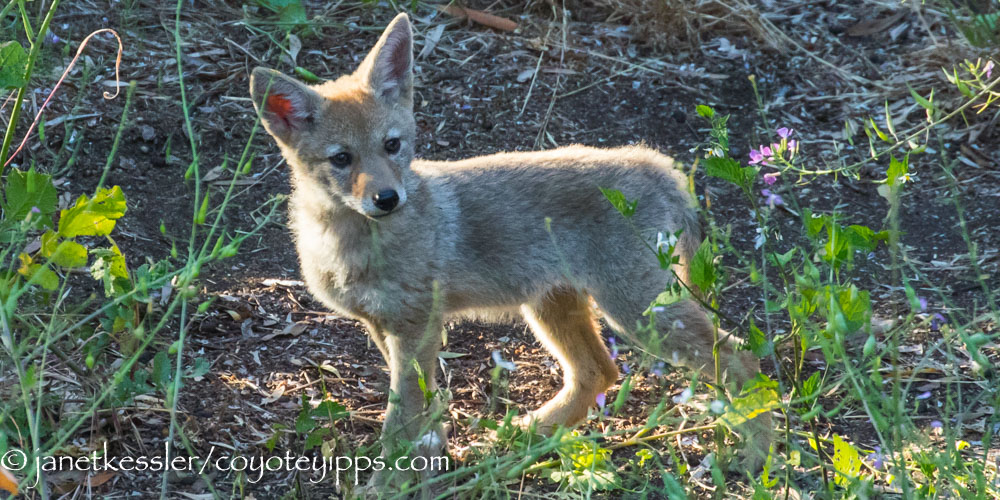
Two-month old coyote pup
We are smack-dab in the middle of pupping season: coyote pups are two months old now! Coyote parents will keep the youngsters hidden away if they can, and they will be very defensive towards any dogs and even people approaching their hideaways. These hideaways are frequently “moved” by coyote parents to keep the pups safe, which makes it hard often to know what areas for us to avoid, so you just have to be on the alert always for their presence and keep your dog well away from them. For a quick summary of what behaviors you can expect if you have a dog, and what you can do to avoid conflict, please click HERE.
- Dad with 2 month old
- 3-month old
- 3-month old

Dad with three month old pup
‘Till Death Do Us Part?
15 May 2020 5 Comments
in breeding season, care for each other, communication, coyote behavior, coyote injuries, coyote mating behavior, coyote reactions to dogs, coyotes and human behavior, families, father coyote behavior, mating season, pair behavior, parenting, pupping, reactions to a human, territoriality
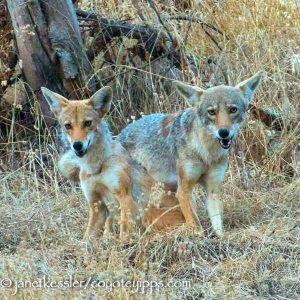 Introduction: That “coyotes are known to mate for life” is something most of us have heard. In fact, I think it’s the only reality I’d ever seen in 13 years. However, as events in one of my families unfolded in early February of this year, I had to question this. My own perception of the turn of events came in bits and pieces and in fits and starts as revealed through a field camera which was out only at night, and not always then. My own desire for this pair-bond to be everlasting caused me to latch onto any details to support my belief, and herein lies a sort of soap opera aspect to the story which I weave into the ending. My ‘hopeful speculations’, along with background history have grown this posting into an unusually long one — a mini-tome! Yikes!
Introduction: That “coyotes are known to mate for life” is something most of us have heard. In fact, I think it’s the only reality I’d ever seen in 13 years. However, as events in one of my families unfolded in early February of this year, I had to question this. My own perception of the turn of events came in bits and pieces and in fits and starts as revealed through a field camera which was out only at night, and not always then. My own desire for this pair-bond to be everlasting caused me to latch onto any details to support my belief, and herein lies a sort of soap opera aspect to the story which I weave into the ending. My ‘hopeful speculations’, along with background history have grown this posting into an unusually long one — a mini-tome! Yikes!
Please know that every single one of these photos, as all the photos on this blog, were taken as photo-documentation at the time these events occurred. I don’t substitute a photo from another time or place that might simply “do”. What you see, and what you read, are authentic and concurring.
Background. The years immediately leading up to this story serve as an important point of reference for what comes later, so I’ll sum those up here.
Pupping Season Gets Off To A Tough Start: One Family
23 Apr 2020 10 Comments
The coronavirus may be adding a degree of uncertainty, stress, anxiety, and worry to our lives. But what if you were already experiencing worry and anxiety from some big change in your life, say having a baby (or even triplets): imagine the compounding effects of the coronavirus fallout! Well, that’s what’s going on with our coyotes.
Reproduction is not a casual event for them. They go through a lot of planning, pain, and effort to insure the safety of their litters, and suddenly, with the upheaval of the coronavirus, danger intrudes on them, nullifying all their work to guard against it. Dogs and coyotes are naturally at odds, so they must be kept apart.
Courting behavior here in San Francisco began back in February. This is when the “pupping season” officially began for me. Mama and Papa coyotes were “trysting” on February 11th: he jealously followed her around, shadowing her closely and keeping an eye on her every move. She, on the other hand, ignored him. She remained aloof and kept her “social distance” from him. When she was ready — and that would not be until several days after the 11th — she would let him know, but until then she would be edgy and greet him with repeated snarls and repulses as he persistently crowded her.
- Mom: “Get away from me”
- Dad: “Whoa, I’m going, I’m going”
I often see this female sunning herself out in an open field throughout the year. HE, on the other hand, is further along in years: for self-protective reasons, he is out less. I continue to see him at regular intervals, but those intervals have become longer over the last few years, so it’s a real treat when I do see him. I was able to catch this afternoon of courting behavior probably only because he was compelled to follow her out into her open field.
After a 63 day gestation period, I started watching for him on his “birthing rock”: that’s where he has always stood guard during the birth and week or so after the birth of a new litter. Only the rock “announcement” didn’t happen this year: I sensed unease and anxiety in the pairs’ movements instead, especially Dad’s.
Every year the coyotes have been able to keep their “big secret” deep in the woods where the brambles and thick underbrush provided the protection they needed. It’s been an area they could count on year after year after year.
This year the situation turned topsy turvy because of the coronavirus backwash: the parks became one of the few places people could go due to the shelter-in-place orders. The sudden surge in constant visitors and loose dogs has created an upheaval for these coyotes in this park, and for coyotes elsewhere.
I was able to watch dog intrusions at the bramble divide — the one dividing their private wilderness area from public paths and open space — over several days. The dogs’ repeated pushing their way through the protective passageway served to break down more and more of the twigs and dense foliage that formed a barrier into the deeper woods . . . and then even more dogs were attracted to this spot. Most dogs are not leashed here, so they head pell-mell wherever their noses lead them, and coyote smells are one of the attractions.
Signs at all entrances to the park prescribing, “leashed dogs only”, are ignored. I’ve filled-in during past pupping seasons with additional signs, but these are removed by angry dog walkers who feel it is their right to run their dogs unleashed.
The Presidio is a park in the city with the best signage I have yet seen: these are four-foot signs with strong, no-nonsense language highlighted in red, and strategically placed at multiple repeated intervals: their message is very clear and un-ignorable: “dogs PROHIBITED in this area”. So, too, by the way, are their “Stay 6 feet apart” social distancing coronavirus signs. Because of the coronavirus, the golf course at the Presidio is closed to golfers, and people are allowed to spread out and enjoy the out-of-doors there. Most people abide by the rules: 6 feet apart – masks – politeness. And the golf-course is almost dog-free.
- 4′ signs in the Presidio
- 4′ signs in the Presidio
- Coronavirus sign in the Presidio
But even there, where the signs are almost in your face, there is a trickle of hikers who walk right down the middle of a path, and when you ask them to please give you six feet, they laugh scornfully, or run past you (at a 2 foot distance) without giving you time to move. They don’t like the rules and feel the rules don’t apply to them. And for them, the dog rules apply even less. Dogs leashed and unleashed are not allowed on the golf-course, but there almost always are some.
So, back to this particular coyote family. For a while I was seeing Dad’s scat along the path surrounding the once-secret passageway — this was his attempt to demarcate and ward off any dog intruders. Of course, few people or domestic dogs know how to read this kind of messaging, and the dogs could care less anyway.

Dad’s scat appeared for a while at regular intervals along a path adjacent to a chosen denning site.
I’m sure it’s because of this coronavirus upheaval that I found this coyote pair, close to their birthing due date, visiting a park almost a mile away. I’m sure they were staking out a safer place for their family. But, as things turned out, that location also had dogs that chased them. It was not chosen as a nesting spot, and neither was the underside of a porch which they checked out intensively. The coyotes are now back at their long-term territory with their new den tucked into the farthest reaches of the park, in the safest place they could find: it is not the place they have used for so many years. And they are avoiding the flood of dogs and people as much as possible by moving around much more exclusively at night than before.
- She marks in the recently visited territory
- He clings to the periphery to avoid detection in that distant area
- Far and away from “home” turned out to be just as dangerous. [above]
- Maybe under a porch this year? [below]

Below is a video of Dad who came out into the open a couple of days ago as people and dogs passed by and watched him from the surrounding trail: he’s eating grass and regurgitating, a behavior caused by undue stress. During this pupping season, the usual anxiety, worry, strain and unease of the season appear doubly compounded for them by the overwhelming increase of human activity in their parks and loose dogs intruding on them.
So how can you help? Please remember that what’s good and safe for coyotes is good and safe for you and your dog. Coyotes need to protect themselves, their mates, their pups and their denning areas. They’ll stand up to intrusions if necessary, especially during pupping season, which is right now. They’ll even charge at and message dogs nearby who are potential intruders. Pupping season is a stressful and demanding time for them in good times. But when they are overwhelmed, as during this coronavirus time, it becomes more difficult and more stressful for them. We all respond to stress and high-strung situations by snapping at those around us. Hey, let’s relieve the pressure instead of increasing it.
Please keep your dogs close to you on the trails. The minute you see a coyote, especially now during this anxious time for them, leash your dog and walk away from the coyote and keep walking away. You will be showing the coyote that they are not “an object of interest” to you, that you are just minding your own business and not interested in interfering with them. Coyotes need to know this. They just want to be left alone and the dogs to be kept away from them and their den sites. And since you should want this too, walking away solves the problem.
You may be followed by a coyote who is suspicious of your motives. Again, just keep walking away. If a coyote follows too closely, you can turn and stare at him/her as you move away, or toss a small stone at its feet (not AT it so as to injure it), as you walk away. For more on coexisting during pupping season, please see my post from March of 2015: Pupping Season: What Behaviors to Expect If You Have A dog, and What You Can Do.
© All information and photos in my postings come from my original and first-hand documentation work which is copyrighted and may only be re-used with proper credit.
Coyote Family Playtime for a 3-Month Old Singleton Pup
02 Aug 2019 5 Comments
in coyote behavior, coyote habitat, coyote parenting, coyote pups, family interactions, pupping, siblings, waiting
This tiny family responds to sirens!
She’s an “only pup” — she has no litter mates. An “only pup” is known as a “singleton” pup. But she is not an “only child” because she has an older brother: a yearling born the year before. He was part of a litter of five, and is the only youngster from that litter to remain part of the family. That yearling plays with the pup, as do Mom and Dad, as you’ll see in the video.
Nighttime is when coyote families engage in most of their family activities: the whole family plays together on and off — when adults aren’t off hunting — during the length of the evening. And then they rest or sleep in different locations during the daytime.
The video above is a composite from one of my rarer daylight captures of family play. Note that, after the intense and fun play session above, the “adults”, trickle off, one at a time, in the end leaving the pup alone for the rest of the day. At night, too, they leave her for long extended periods of time when they go off hunting. She knows she must stay home and keep hidden.
After watching them leave, the pup wanders sadly, slowly, and unenthusiastically back — you can tell this by the lack of energy in her pace — to her hiding place. And that’s how the days go by as she is growing up.
Trap Cameras: Dad Patrols / Pup Explores
19 Jul 2019 2 Comments
in care for the young, coyote behavior, coyote parenting, coyote paths, coyote pups, dens, father coyote behavior, pupping, trap cameras Tags: trap cameras, trap cameras are not benign, use of trap cameras
Today, I’m posting a video sequence of a coyote on his patrolling rounds, and of a youngster investigating the area, captured remotely on a trap camera. Pups are 3 months old now and their curiosity is insatiable, of course! But this posting is more about trap cameras which aren’t as benign as most people think.
Use of trap cams and what I’ve seen. I’ve used them extremely sparingly in the past. Out of respect for what coyotes want and so as to observe natural rather than fearful or protective behavior, I stay away from denning areas: rather, I’ve used field cameras to count pups after they start exploring well away from their dens. And I’ve used them more recently for tracking an interloper coyote who was driven from her territory by another coyote.
There IS a difference between trap-cameras and human hand-held cameras, but not necessarily in the way people imagine: I’m referring to the intrusiveness factor. In some ways they may be less interfering than human presence, but in many ways they are more so.
Some of the reactions of coyotes to my and other trap cameras as seen in images from those cameras led to my doing a mini-study on trap-cameras. The outcome: I found that these devices are surprisingly intrusive from the animals’ point of view as seen by the images of their reactions to them. On the other hand, although my motives have been “tested” a couple of times by coyotes (I’ve always walked away when this happens), this is rare. Although they’ve watched me, they effectively have not reacted to me, a human photographing them: this is why I’m able to document their natural family lives. We have plenty of other humans passing through the parks in San Francisco so I just blend in with the rest of them. If these had been non-urban coyotes not used to having humans around, I’m sure I would not be able to do what I do.
Conversely, coyotes DO routinely react to trap cameras, often adversely, and they are as aware of them as they are of any human in their area.
For the coyote, I think it boils down to an “understandable known” which is a human taking photos (and I’m talking about doing so respectfully and from a respectable distance), versus an “incomprehensible unknown” which are the clicks and whirrs and flashes of a contraption without a human presence yet “triggered” and focused on them when they appear: that’s when the lights and the noises go on. I’ve even seen several coyotes test this: they stand in the distance waiting for the IR lamp to turn off or the noises to begin, and then they make a slight movement that confirms THEY are the triggers.
So how are these field cameras intrusive? Coyotes often become startled by them, stopping dead in their tracks. The cameras elicit stares and investigative or wary reactions, especially as the coyote gets closer to them. The cameras all make sounds, and coyotes can hear even the faintest of noises, even if you can’t. So even if these cameras are missed visually by coyotes, they still know they are there — this must make them even more disturbing. Even the “black glow” cameras, where the IR flash is invisible to humans, are very visible to coyotes. I’ve actually seen coyotes interact with these cameras by angrily defecating in front of them, kicking dirt in anger at them, and even taking them down when they can [see photos and video below]. Wow!
When the field cameras are up high and unreachable, they appear to be ignored or not to be seen, or so I thought, until I looked closer. When I set them on high ledges where they could be accessed by animals — they were. So it’s a fallacy that trap cameras are not intrusive: coyotes know these are human instruments and likely malevolent in some way. Coyotes may even know you are spying on them.
“In the name of science” is often accepted as a good excuse for using them. Scientists want their “facts”, but people should know that they do impact the animals on deeper levels than they might be aware of.
Having said all this, I have used trap cameras, as I stated above. Recently, my cameras were left up overtime when I neglected to pick them up for several days because I was too busy to go get them, and I discovered that the cameras caught some behaviors worth posting, always sprinkled with the reactions I’ve just described.
Some of what the cameras caught include: Dad bringing back prey to his pups, a mom regurgitating her food for her only pup, a youngster waiting around impatiently for his parents to return from hunting, older sibling playing with a younger pup, a mom playing with her youngsters as though she were one of them, parents trying to shoo their youngster into hiding in the bushes but youngster doesn’t heed them, a dad pacing and standing very still as he listens carefully for a possible intruder he’s heard! I’ll post some of these in the coming weeks. The video today shows a pup exploring with insatiable curiosity, and Dad patrolling before that.
Some images and a video of coyotes encountering trap cameras. Here are examples of how coyotes reacted with suspicion & investigation, kicking dirt in anger, defecating in anger and as a message, and knocking down the camera [Press one of the images to scroll through the gallery].
- Suspicion & investigation
- Kicking dirt in anger in front of cam
- Defecating in front of camera
- knocking over the camera
Another example: https://www.ktvq.com/entertainment/trending/video-extra-we-said-no-cameras
All About Coyote Pups: A Primer
18 Jun 2019 10 Comments
in coyote behavior, coyote pups left alone, father coyote behavior, mother coyote behavior, pupping Tags: all about coyote pups, coyote pups, coyote pups in San Francisco
I’ve put together some information on coyote pups based predominantly on my own observations. Other information is included, including some hearsay, which I’ve stated as such. Push the underlined links I’ve provided for even more information.
Coyote pups are about two months old now here in San Francisco.
Etiquette: Please stay away from any place where you even suspect a den might be, and please especially keep your dogs away from those areas. Besides cars, dogs are coyotes’ biggest threat in urban areas. You can prevent stress and trauma to yourself, your dog, and coyote parents with new pups by leashing your dogs if you must move through such an area. Word-of-mouth from other park visitors about a den’s general whereabouts should be enough for you to voluntarily avoid those areas.
Terminology: Baby coyotes are referred to as “pups” (not cubs)!
Dates of birth: In San Francisco, pups are normally born towards the beginning of April after a gestation of 63 days. Coyotes come into heat just once a year (as opposed to dogs’ twice a year cycle) — they can only produce one litter a year which is usually born sometime in the Springtime. The courting behavior which leads to pups can be observed at the end of January.
Litter Sizes: A “litter” is the group of pups that are born and raised together in one family. Some yearlings from the previous year’s litter or before — those that didn’t disperse (leave) — may remain in the family and may even help out a little by bringing in food for the youngsters. I have seen anywhere from one to seven pups born in one litter in San Francisco: that’s quite a spread! I have heard of larger litters, as many as 11 to 19 (not in San Francisco), but I’ve also heard (but not seen) that this very large litter size may actually be the result of “den sharing”: two females sharing the same den.
From my own observations, I’ve seen litters vary in size over several consecutive years from the same parents as follows: Maeve and Toughy 1-2; Ma’am and Monte 2-5-1; Cai and Yote 7-2-? (haven’t had a chance to count this year’s yet); Maya and Ivan (3-4-5); Chert and Silver 1-0-0-0-4;. These are all variations of normal litter sizes. The exception was the five litters where there were sometimes no survivals: this anomaly was almost certainly related to inbreeding in this family; Chert went through the motions of having pups during those three years of no pups, but none ever appeared. Besides these normal, small fluctuations, the litter sizes I’ve seen in San Francisco have not changed over the 12 years that I’ve been studying coyotes, even though the coyote population here has grown from an initial 8 in 2002 to several score and appears to be at its saturation point, as revealed by more and more brutal territorial battles that have displaced resident coyotes.
So although I’ve heard it speculated that coyotes “regulate” their litter size: I’ve not seen an indication of this here in San Francisco. They appear to just ‘get what they get’ — like the rest of us (those who don’t take hormones). And rather than the proviso that “locations dictate litter size”, I would think that litter size might have a genetic component. I know that natural multiple births seem to run in human families, so might litter size also have a genetic component?
Newborn pup size: Coyote pups at birth weigh between 1/2 and 1 pound. This has been measured by wildlife rehabilitation facilities which take in these newborns. Weight can vary substantially between the pups in one family which may include some “runts”. Their personalities also develop differently. Some, right from the start are adventuresome and exploratory: they are curious about everything and wander far, rather brazenly. Others have more of a built-in wariness and fear: they are on-edge and more anxious and keep closer to home. Some are more interactive and social, involved in a lot of rough-house playing and teasing, while others are more withdrawn, preferring to sit back and watch the others. Each of these has it’s benefits for survival: one is not necessarily a “better” personality type than another.
Dens and birthing: Coyote pups are born in dens which were either dug for this purpose by their parents or they were pre-existing “homes” of other animals, such as raccoons or skunks, that were broadened and enlarged by the to-be coyote parents for their purposes. A den can also be an existing hole in the ground, cavities under tree trunks, a depression with good covering, or a nook under a ledge. I have only seen dens long after they were abandoned, I have never seen an occupied den: I keep my distance from these.
Coyote dens are used only for a short time: for birthing and nursing during the very early life of pups and for the few months thereafter. Dens are outgrown, just as are birds’ nests or human cradles, after which the youngsters sleep in protected or hidden areas as do the parents. At around six weeks of age pups begin venturing beyond the den, but they’ll stick close to the den for much longer than that.
Here is a video of a wolf giving birth: I think we can assume that it must be pretty similar to what a coyote goes through. They emit howls as they give birth, and you hear a little of that here:
Do mothers stay in the dens for an extended period of time after giving birth? Well, if some do [this video shows pups right after, and pups’ first howls], it’s not a hard-and-fast behavior practice: I’ve seen one mother out within a day of giving birth and I’ve seen others out in far less than a week.
Coyote pups may be left all alone for extended periods of time while the parents go off hunting. So, please don’t “save” what you think are “abandoned” pups — parents are likely simply off hunting. NO ONE can raise coyote pups as well as their own parents. You are actually hurting their chances for survival if you take their welfare into your own hands. If you truly believe they’ve been abandoned, then monitor them for several days before taking them to a wildlife center.
Nourishment: Coyote pups live on their mother’s milk alone for the first few weeks. This diet is soon supplemented with regurgitated food at about one month of age. The regurgitated food consists of whatever the parents consume, mostly rodents, but also fruit, amphibians, insects, birds and even garbage. How long do the youngsters lactate? I’ve seen mothers’ tit size shrink by the end of May, so I assume by that time the youngsters are well accustomed to semi-solid diets and on their way to whole prey soon. First, dead prey is brought to the youngsters, after which the pups are taken out to practice hunting on their own. Interestingly, I’ve seen coyotes over one year of age still being brought regurgitated food from a father: the youngsters approach Dad from below his chin, wedging their muzzles under his upper lip. This causes the regurgitation response. Dad then expels the food onto the ground, and the youngsters grab and eat it.
As the youngsters grow, Dad continues his contributions in the food department by bringing home prey to help feed the youngsters. Both coyote parents, unusually, raise the youngsters and you may find Dad at times sitting out and “minding” the offspring, giving Mom a break.
An interesting observation I’ve made is what I call “facilitating.” When the pups are learning to hunt, a mother will kill a rodent and bury it where the pups can easily find it!
Survival rate: Survival rate of pups is known to be low — 20-30% is what the literature says, but what I’ve seen in San Francisco is closer to about 70% from the time the pups can first be seen. However, it should be noted that I myself never know how many pups were actually born because I never intrude into their den areas: I wait to see what a litter is like until Mom brings them out or they are spotted through the bushes. Between birth and when I see them, there could have been more pups who didn’t make it.
First appearances: You might glimpse youngsters now, at two months of age, through the bushes, but it won’t be because coyotes want you to. Youngsters are highly protected as they grow up. And if a youngster sees you, he/she is bound to head straight to the bushes to hide! And parents are bound to come out to warn you to stay far, far away!
Family howl session in response to sirens. The howling family consists of Mom and Dad and four two-month old pups! Note that, although coyotes keep youngsters hidden as much as possible, they seem to have no qualms about being heard!
Here is what coyotes look like during their first year of growth:
- First month of life
- Two months old (siblings of different sizes)
- Three months old
- Five months (with Dad)
- Six months with Dad
- 7 months old
- 9 months
- 14 month old siblings
Coyotes may leave home (dispersal) anytime after they are about 9 months of age, which is about January in SF. The earliest I’ve seen was a female who left home at 9 months of age. And the latest I’ve seen was a male who didn’t leave until he was 2.5 years of age, even though his father attempted pushing him out almost a year beforehand. The Presidio has tracked some of these dispersals to 60 miles south of the city, and I’ve been able to track some to vacated niches within the city itself. Many dispersing youngsters get killed by cars during this treacherous dispersal time in their lives. They also come across extremely hostile territorial coyotes who make it clear that they are not one bit welcome.
Keeping Their Secrets As Best They Can
13 Jun 2019 2 Comments
in coexisting with coyotes, coyote parenting, coyote pups, pupping, youngsters
Coyotes’ best kept secret is their pups — or at least they try to keep them a secret. If you happen to see any, it will be because the youngsters ventured beyond where their parents’ were trying so hard to keep them well hidden. The pups I know are all about two months old now here in San Francisco, as seen in the video.
And here is this family’s response to sirens: Mom, Dad, and FOUR youngsters: Although they might not want to be seen, they don’t seem to mind being heard!!
Please stay away from any place where you even suspect a den might be, and please — specifically — keep your dogs away from those areas. It’s so easy to prevent stress and trauma to coyote families with new pups by leashing your dogs and keeping away. Word-of-mouth from other park visitors about the existence of pups should be enough for you to voluntarily avoid those areas with your unleashed dog. Parents will protect and defend their youngsters: why not just avoid the situation to begin with?

If a very young pup notices that s/he is being observed, s/he will run for cover.












